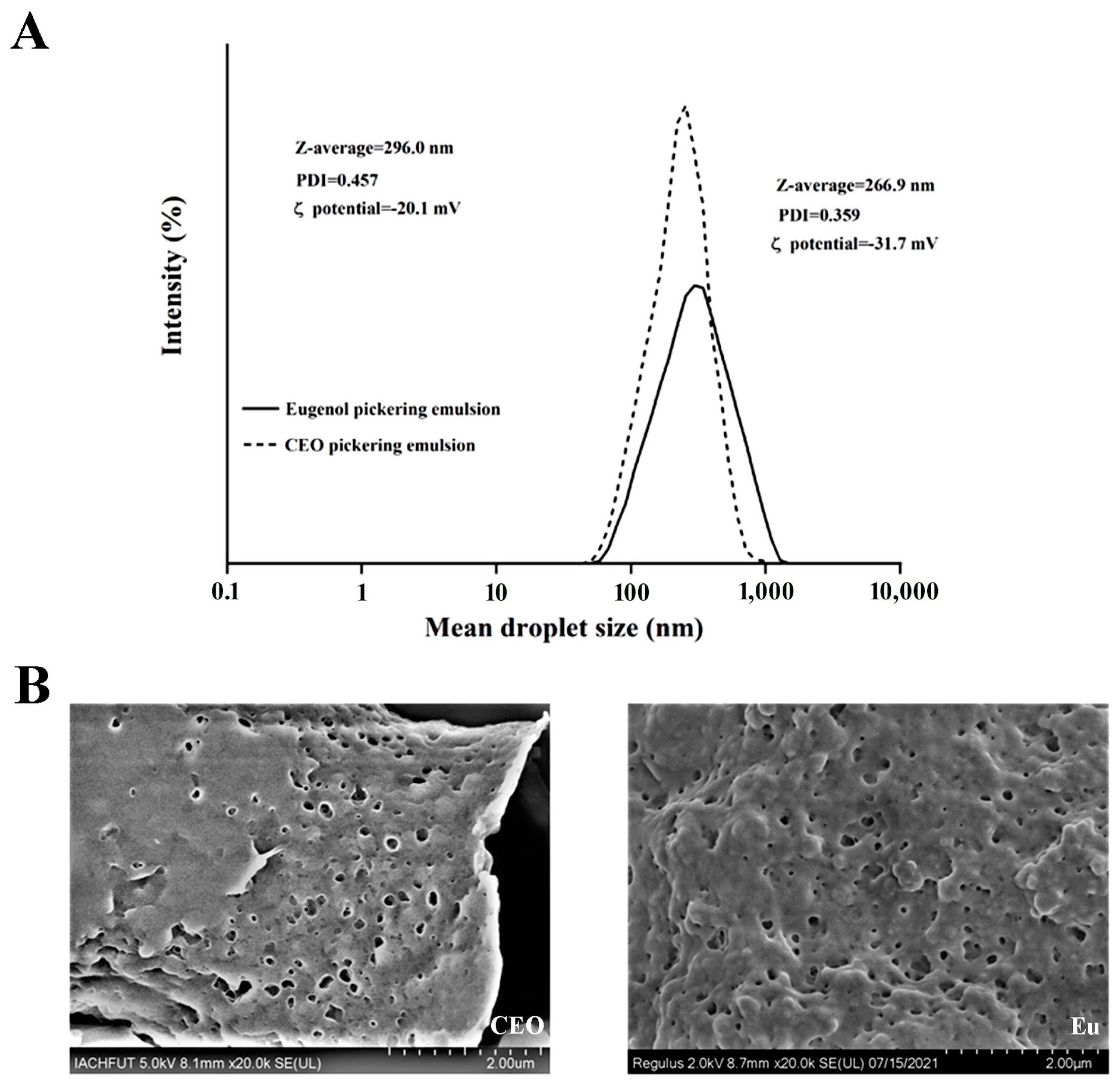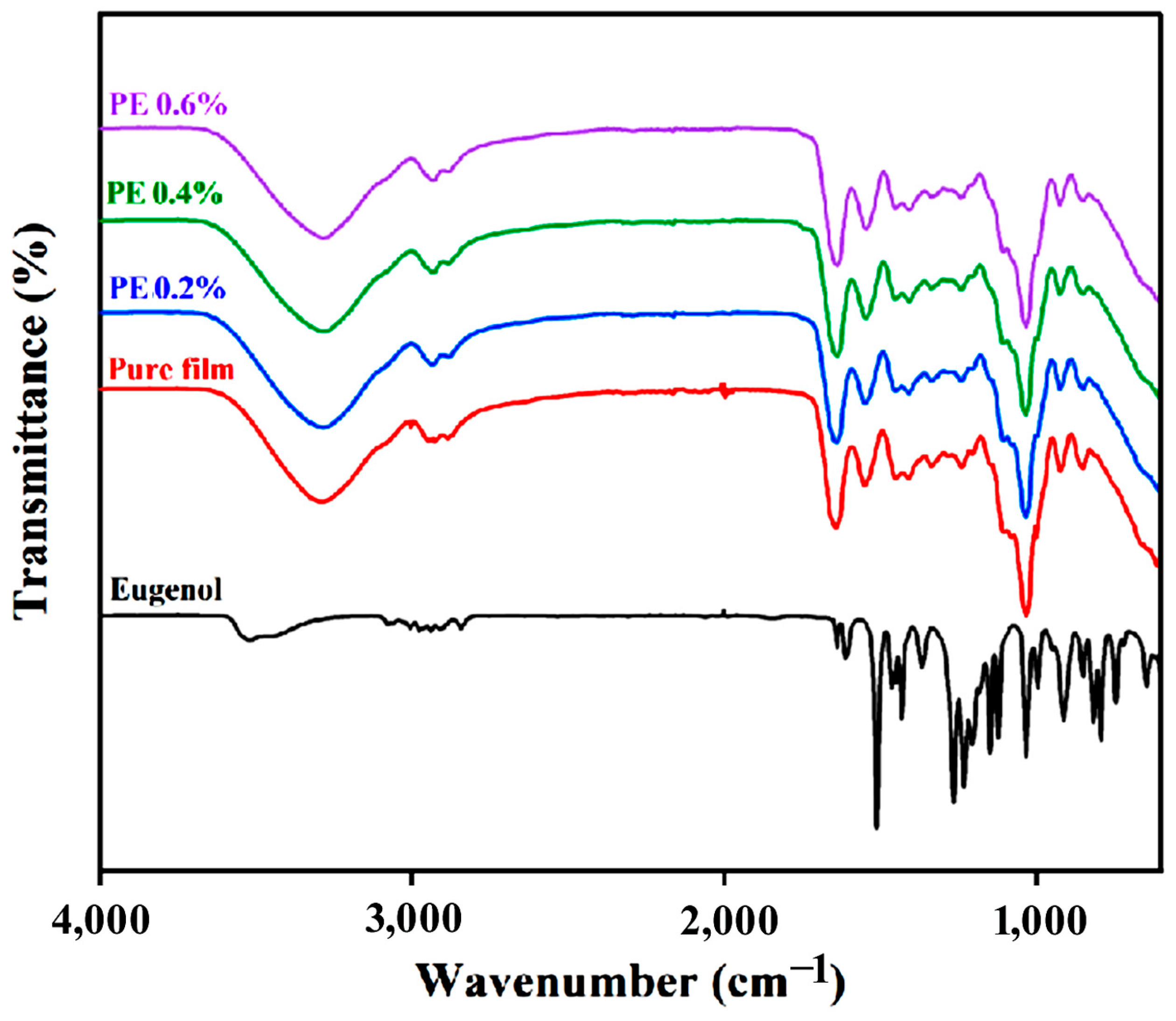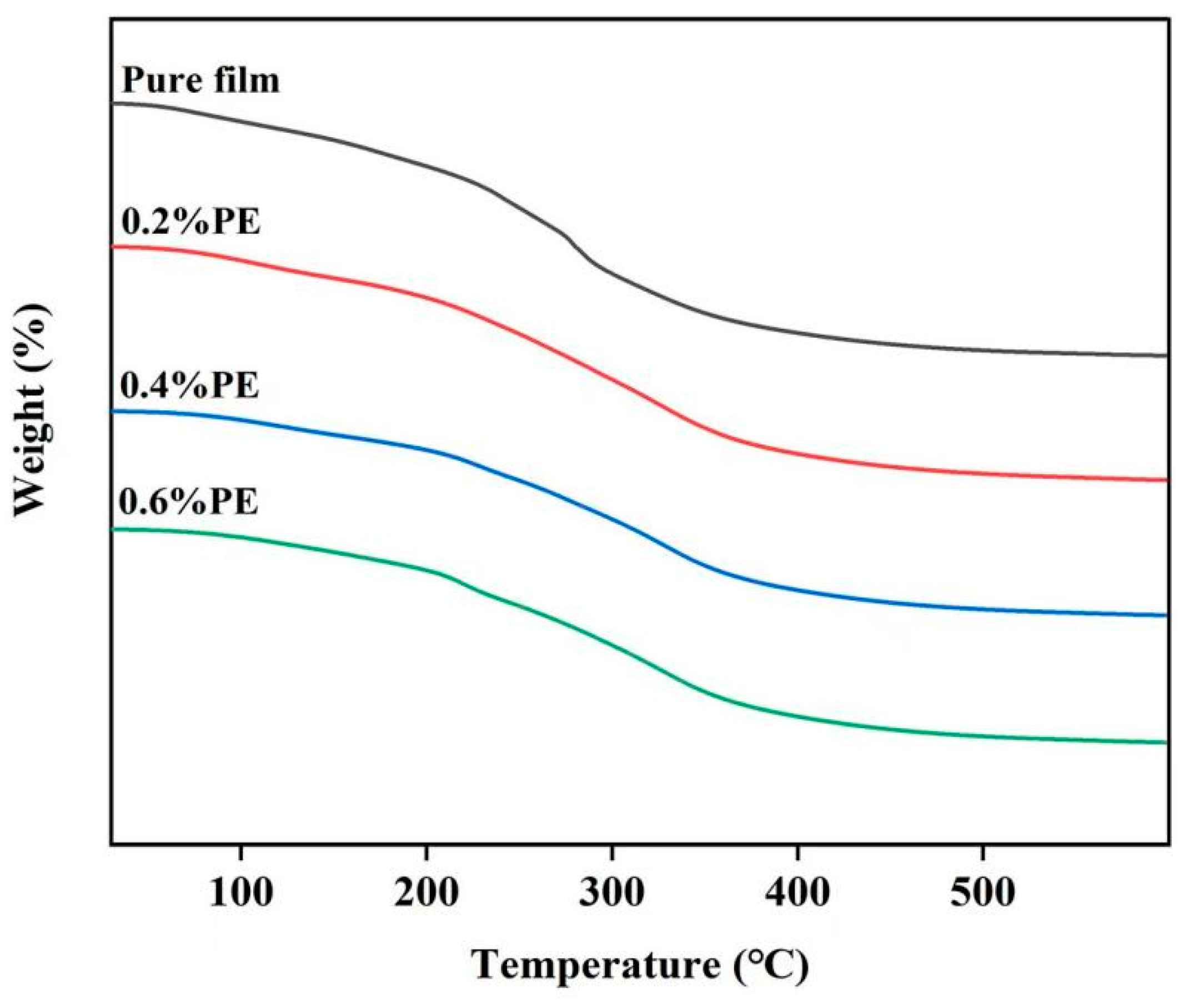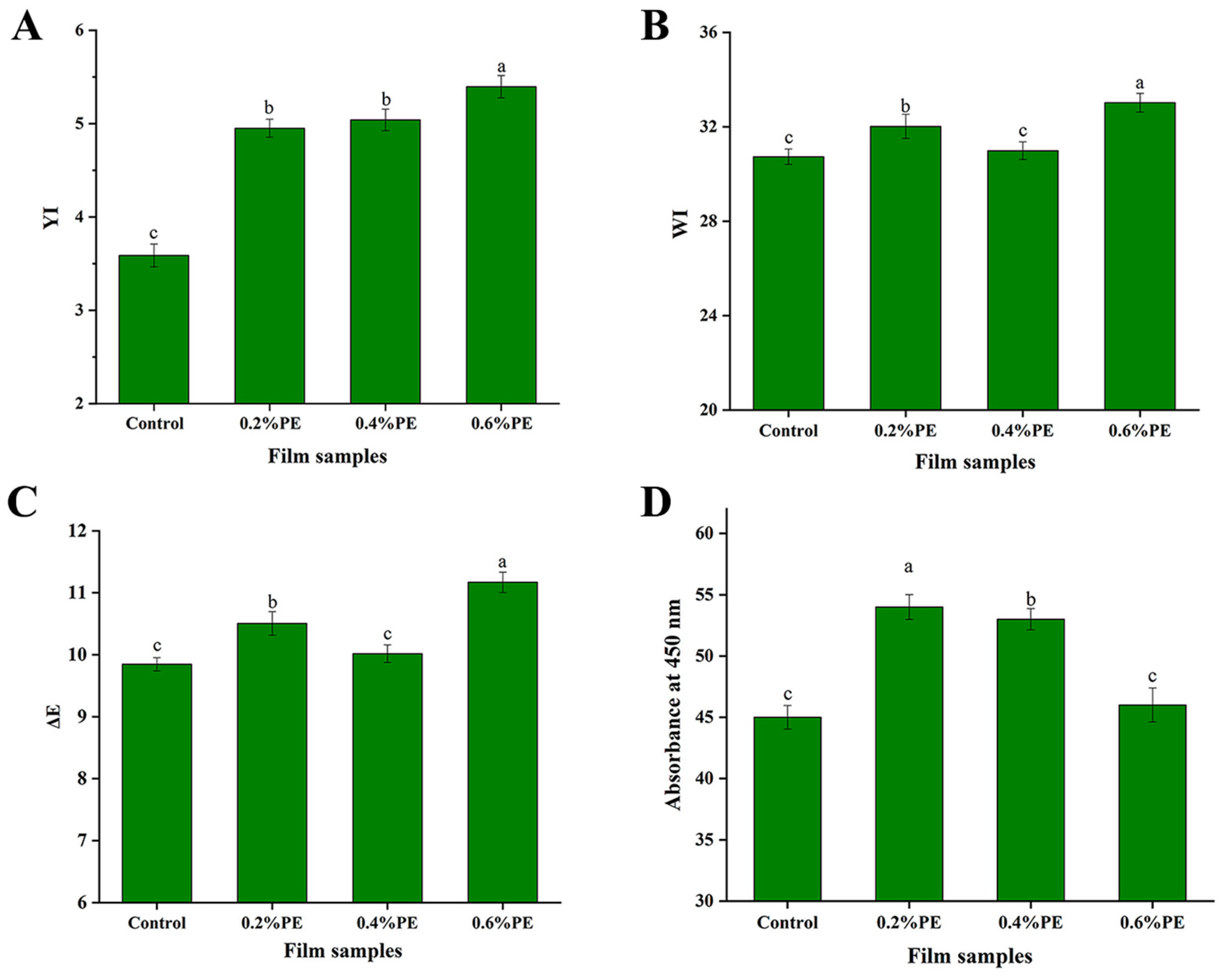Preparation and Characterization of Eugenol Incorporated Pullulan-Gelatin Based Edible Film of Pickering Emulsion and Its Application in Chilled Beef Preservation
Abstract
:1. Introduction
2. Results and Discussion
2.1. Analysis of Emulsion
2.2. Analysis of FT-IR
2.3. Analysis of Scanning Electron Microscope in Cold Field
2.4. Thermogravimetric Analysis
2.5. Analysis of Physical Properties of Thin Films
2.5.1. Analysis of Thickness
2.5.2. Analysis of Mechanical Properties
2.5.3. Analysis of Water Vapor Permeability
2.5.4. Analysis of Chromaticity
2.6. Analysis of pH Value of Chilled Beef
2.7. Analysis of Chromaticity of Chilled Beef
2.8. Analysis of Moisture Content of Chilled Beef
2.9. Analysis of Total Volatile Base Nitrogen (TVB-N) Value of Chilled Beef
2.10. Analysis of Thiobarbituric Acid (TBARS) Value of Chilled Beef
2.11. Analysis of Total Bacterial Count of Chilled Beef
3. Materials and Methods
3.1. Materials
3.2. Preparation of Pickering Emulsion
3.3. Characterization of Emulsion
3.4. Preparation of Films
3.5. FT-IR
3.6. FE-SEM
3.7. Thermogravimetric Analysis
3.8. Characterization of Physical Properties of Films
3.8.1. Thickness and Density of Films
3.8.2. Measurement of Mechanical Properties
3.8.3. Water Vapor Permeability
3.8.4. Chromaticity of Films
3.9. Pretreatment of Chilled Beef
3.10. Determination of pH Value
3.11. Determination of Chromaticity
3.12. Determination of Moisture Content
3.13. Determination of Total Volatile Base Nitrogen (TVB-N) Value
3.14. Determination of Thiobarbituric Acid (TBARS) Value
3.15. Determination of Total Mesophilic Aerobic Bacteria (TMAB)
3.16. Data Analysis
4. Conclusions
Author Contributions
Funding
Data Availability Statement
Conflicts of Interest
Sample Availability
References
- Zhao, S.; Li, N.; Li, Z.; He, H.; Zhao, Y.; Zhu, M.; Wang, Z.; Kang, Z.; Ma, H. Shelf life of fresh chilled pork as affected by antimicrobial intervention with nisin, tea polyphenols, chitosan, and their combination. J. Food Prop. Int. 2019, 22, 1047–1063. [Google Scholar] [CrossRef]
- Kęska, P.; Wójciak, K.M.; Stasiak, D.M. Influence of Sonication and Taraxacum Officinale Addition on the Antioxidant and Anti-ACE Activity of Protein Extracts from Sous Vide Beef Marinated with Sour Milk and after In Vitro Digestion. Molecules 2020, 25, 4692. [Google Scholar] [CrossRef] [PubMed]
- Verma, A.K.; Chatli, M.K.; Kumar, P.; Mehta, N. Assessment of quality attributes of porcine blood and liver hydrolysates incorporated pork loaves stored under aerobic and modified atmospheric packaging. J. Food Sci. Technol. 2022, 59, 1114–1130. [Google Scholar] [CrossRef] [PubMed]
- Dini, H.; Fallah, A.A.; Bonyadian, M.; Abbasvali, M.; Soleimani, M. Effect of edible composite film based on chitosan and cumin essential oil-loaded nanoemulsion combined with low-dose gamma irradiation on microbiological safety and quality of beef loins duri-ng refrigerated storage. J. Biol. Macromol. Int. 2020, 164, 1501–1509. [Google Scholar] [CrossRef] [PubMed]
- Zhang, Y.P.; Wang, X.; Shen, Y.; Thakur, K.; Zhang, J.G.; Hu, F.; Wei, Z.J. Preparation and Characterization of Bio-Nanocomposites Film of Chitosan and Montmorillonite Incorporated with Ginger Essential Oil and Its Application in Chilled Beef Preservation. Antibiotics 2021, 10, 796. [Google Scholar] [CrossRef]
- Mizi, L.; Cofrades, S.; Bou, R.; Pintado, T.; López-Caballero, M.E.; Zaidi, F.; Jiménez-Colmenero, F. Antimicrobial and antioxidant effects of combined high pressure processing and sage in beef burgers during prolonged chilled storage. Innov. Food Sci. Emerg. 2019, 51, 32–40. [Google Scholar] [CrossRef]
- Almasi, H.; Azizi, S.; Amjadi, S. Development and characterization of pectin films activated by nanoemulsion and Pickering emulsion stabilized marjoram (Origanum majorana L.) essential oil. Food Hydrocoll. 2019, 99, 105338. [Google Scholar] [CrossRef]
- Wan, J.; Pei, Y.; Hu, Y.; Ai, T.; Sheng, F.; Li, J.; Li, B. Microencapsulation of Eugenol Through Gelatin-Based Emulgel for Preservation of Refrigerated Meat. Food Bioprocess Technol. 2020, 13, 1621–1632. [Google Scholar] [CrossRef]
- Ni, Z.J.; Wang, X.; Shen, Y.; Thakur, K.; Han, J.Z.; Zhang, J.G.; Hu, F.; Wei, Z.J. Recent updates on the chemistry, bioactivities, mode of action, and industrial applications of plant essential oils. Trends Food Sci. Technol. 2021, 110, 78–89. [Google Scholar] [CrossRef]
- Sharma, S.; Barkauskaite, S.; Jaiswal, A.K.; Jaiswal, S. Essential oils as additives in active food packaging. Food Chem. 2021, 343, 128403. [Google Scholar] [CrossRef]
- Wang, W.; Zhang, Y.; Yang, Z.; He, Q. Effects of incorporation with clove (Eugenia caryophyllata) essential oil (CEO) on overall performance of chitosan as active coating. J. Biol. Macromol. Int. 2021, 166, 578–586. [Google Scholar]
- Dannenberg, G.D.; Funck, G.D.; Cruxen, C.E.; Marques, J.D.; Silva, W.P.; Fiorentini, Â.M. Essential oil from pink pepper as an antimicrobial component in cellulose acetate film: Potential for application as active packaging for sliced cheese. LWT Food Sci. Technol. 2017, 81, 314–318. [Google Scholar] [CrossRef]
- Shao, Y.; Wu, C.; Wu, T.; Li, Y.; Chen, S.; Yuan, C.; Hu, Y. Eugenol-chitosan nanoemulsions by ultrasound-mediated emulsification: Formulation, characterization and antimicrobial activity. Carbohydr. Polym. 2018, 193, 144–152. [Google Scholar] [CrossRef] [PubMed]
- Hu, F.; Tu, X.F.; Thakur, K.; Hu, F.; Li, X.L.; Zhang, Y.S.; Zhang, J.G.; Wei, Z.J. Comparison of antifungal activity of essential oils from different plants against three fungi. Food Chem. Toxicol. 2019, 134, 110821. [Google Scholar] [CrossRef] [PubMed]
- Zhang, T.; Lu, Z.; Zhang, L.; Li, Y.; Yang, J.; Shen, J.; Wang, J.; Niu, Y.; Xiao, Z.; Chen, L.; et al. Preparation of hollow mesoporous silica nanorods for encapsulating and slowly releasing eugenol. Chin. Chem. Lett. 2020, 31, 3135–3138. [Google Scholar] [CrossRef]
- Haro-González, J.N.; Castillo-Herrera, G.A.; Martínez-Velázquez, M.; Espinosa-Andrews, H. Clove Essential Oil (Syzygium aromaticum L. Myrtaceae): Extraction, Chemical Composition, Food Applications, and Essential Bioactivity for Human Health. Molecules 2021, 26, 6387. [Google Scholar] [CrossRef]
- Liu, J.; Shao, Y.; Yuan, C.; Takaki, K.; Li, Y.; Ying, Y.; Hu, Y. Eugenol-chitosan nanoemulsion as an edible coating: Its impact on physicochemical, microbiological and sensorial properties of hairtail (Trichiurus haumela) during storage at 4 °C. J. Biol. Macromol. Int. 2021, 183, 2199–2204. [Google Scholar] [CrossRef]
- Talón-Argente, E.; Vargas, M.; Chiralt, A.; González Martínez, M.C. Antioxidant starch-based films with encapsulated eugenol. Application to sunflower oil preservation. LWT-Food Sci. Technol. 2019, 113, 108290. [Google Scholar] [CrossRef]
- Celebioglu, A.; Uyar, T. Electro hydrodynamic encapsulation of eugenol-cyclodextrin complexes in pullulan nanofibers. Food Hydrocolloid. 2021, 111, 106264. [Google Scholar] [CrossRef]
- Nagaraju, P.G.; Sindhu, P.; Dubey, T.; Chinnathambi, S.; Priyadarshini, C.G.P.; Rao, P.J. Influence of sodium caseinate, maltodextrin, pectin and their Maillard conjugate on the stability, in vitro release, anti-oxidant property and cell viability of eugenol-olive oil nanoemulsions. J. Biol. Macromol. Int. 2021, 183, 158–170. [Google Scholar]
- Pateiro, M.; Munekata, P.; Sant’Ana, A.S.; Domínguez, R.; Rodríguez-Lázaro, D.; Lorenzo, J.M. Application of essential oils as antimicrobial agents against spoilage and pathogenic microorganisms in meat products. J. Food Microbiol. Int. 2021, 337, 108966. [Google Scholar] [CrossRef] [PubMed]
- Feng, T.; Wang, X.; Fan, C.; Wang, X.; Wang, X.; Cui, H.; Xia, S.; Huang, Q. The selective encapsulation and stabilization of cinnamaldehyde and eugenol in high internal phase Pickering emulsions: Regulating the interfacial properties. Food Chem. 2023, 401, 134139. [Google Scholar] [CrossRef]
- Shah, B.R.; Dvořák, P.; Velíšek, J.; Mráz, J. Opening a new gateway towards the applications of chitosan nanoparticles stabilized Pickering emulsion in the realm of aquaculture. Carbohydr. Polym. 2021, 265, 118096. [Google Scholar] [CrossRef]
- Shen, Y.; Ni, Z.J.; Thakur, K.; Zhang, J.G.; Hu, F.; Wei, Z.J. Preparation and characterization of clove essential oil loaded nanoemulsion and pickering emulsion activated pullulan-gelatin based edible film. J. Biol. Macromol. Int. 2021, 181, 528–539. [Google Scholar] [CrossRef] [PubMed]
- Li, Y.; Zhao, R.; Li, Y.; Zhou, Z. Limonin Enhances the Antifungal Activity of Eugenol Nanoemulsion against Penicillium Italicum In Vitro and In Vivo Tests. Microorganisms 2021, 9, 969. [Google Scholar] [CrossRef] [PubMed]
- Gao, X.F.; Liu, Q.; Qing, H.; Mu, K.M.; Zhang, J.; Zhang, D.; Li, H.; Mao, S.J. Development of eugenol-loaded submicron emulsion and its antiepileptic effect through regulating the oxidative stress. J. Pharm. Int. 2020, 587, 119724. [Google Scholar] [CrossRef] [PubMed]
- Hashtjin, A.M.; Abbasi, S. Nano-emulsification of orange peel essential oil using sonication and native gums. Food Hydrocoll. 2015, 44, 40–48. [Google Scholar] [CrossRef]
- Wan, J.; Hu, Y.; Ai, T.; Ye, S.; Huang, Q.; Yang, Q.; Li, J.; Li, B. Preparation of thermo-reversible eugenol-loaded emulgel for refrigerated meat preservation. Food Hydrocoll. 2018, 79, 235–242. [Google Scholar] [CrossRef]
- Zheng, K.; Xiao, S.; Li, W.; Wang, W.; Chen, H.; Yang, F.; Qin, C. Chitosan-acorn starch-eugenol edible film: Physico-chemical, barrier, antimicrobial, antioxidant and structural properties. J. Biol. Macromol. Int. 2019, 135, 344–352. [Google Scholar] [CrossRef]
- Liao, Z.; Dong, L.; Lu, M.; Zheng, S.; Cao, Y.; Rogers, M.; Lan, Y. Construction of interfacial crystallized oleogel emulsion with improved thermal stability. Food Chem. 2023, 420, 136029. [Google Scholar] [CrossRef]
- Behjati, J.; Yazdanpanah, S. Nanoemulsion and emulsion vitamin D3 fortified edible film based on quince seed gum. Carbohydr. Polym. 2021, 262, 117948. [Google Scholar] [CrossRef] [PubMed]
- Jiang, Y.; Wang, D.; Li, F.; Li, D.; Huang, Q. Cinnamon essential oil Pickering emulsion stabilized by zein-pectin composite nanoparticles: Characterization, antimicrobial effect and advantages in storage application. J. Biol. Macromol. Int. 2020, 148, 1280–1289. [Google Scholar] [CrossRef] [PubMed]
- Wu, M.; Zhou, Z.; Yang, J.; Zhang, M.; Cai, F.; Lu, P. ZnO nanoparticles stabilized oregano essential oil Pickering emulsion for functional cellulose nanofibrils packaging films with antimicrobial and antioxidant activity. J. Biol. Macromol. Int. 2021, 190, 433–440. [Google Scholar] [CrossRef] [PubMed]
- Shi, W.J.; Tang, C.H.; Yin, S.W.; Yin, Y.; Yang, X.Q.; Wu, L.Y.; Zhao, Z.G. Development and characterization of novel chitosan emulsion films via pickering emulsions incorporation approach. Food Hydrocoll. 2016, 52, 253–264. [Google Scholar] [CrossRef]
- Zhu, J.Y.; Tang, C.H.; Yin, S.W.; Yang, X.Q. Development and characterization of novel antimicrobial bilayer films based on Polylactic acid (PLA)/Pickering emulsions. Carbohydr. Polym. 2018, 181, 727–735. [Google Scholar] [CrossRef]
- Silva, M.D.; Lopes, P.S.; Silva, C.F.; Yoshida, C.M. Active packaging material based on buriti oil—Mauritia flexuosa L.f. (Arecaceae) incorporated into chitosan films. J. Appl. Polym. Sci. 2016, 133, 43210. [Google Scholar]
- Hosseini, S.F.; Rezaei, M.; Zandi, M.; Farahmandghavi, F. Development of bioactive fish gelatin/chitosan nanoparticles composite films with antimicrobial properties. Food Chem. 2016, 194, 1266–1274. [Google Scholar] [CrossRef]
- Acevedo-Fani, A.; Salvia-Trujillo, L.; Rojas-Graü, M.A.; Martín-Belloso, O. Edible films from essential-oil-loaded nanoemulsions: Physicochemical characterization and antimicrobial properties. Food Hydrocoll. 2015, 47, 168–177. [Google Scholar] [CrossRef]
- Mahcene, Z.; Khelil, A.; Hasni, S.; Akman, P.K.; Bozkurt, F.; Birech, K.; Goudjil, M.B.; Tornuk, F. Development and characterization of sodium alginate based active edible films incorporated with essential oils of some medicinal plants. J. Biol. Macromol. Int. 2020, 145, 124–132. [Google Scholar] [CrossRef]
- Pak, E.S.; Ghaghelestani, S.N.; Najafi, M.A. Preparation and characterization of a new edible film based on Persian gum with glycerol plasticizer. J. Food Sci. Technol. 2020, 57, 3284–3294. [Google Scholar] [CrossRef]
- Wei, Z.X.; Zhang, J.J.; Zhang, H.C.; Ning, Z.; Zhang, R.Y.; Li, L.J.; Liu, G.Q. Effect of nanoemulsion loading a mixture of clove essential oil and carboxymethyl chitosan-coated epsilon-polylysine on the preservation of donkey meat during refrigerated storage. J. Food Process. Preserv. 2021, 45, e15733. [Google Scholar]
- Monteiro, M.L.; Mársico, E.T.; Conte-Junior, C.A. Application of Active Packaging in Refrigerated Rainbow Trout (Oncorhynchus mykiss) Fillets Treated with UV-C Radiation. Appl. Sci. 2020, 10, 5787. [Google Scholar] [CrossRef]
- Nikzade, V.; Sedaghat, N.; Yazdi, F.T.; Ghoddusi, H.B.; Saadatmand-Tarzjan, M. Development of shelf life kinetic model for fresh rainbow trout (Oncorhynchus mykiss) fillets stored under modified atmosphere packaging. J. Food Sci. Technol. 2019, 56, 663–673. [Google Scholar] [CrossRef]
- Uçak, İ.; Yerlikaya, P.; Khalıly, R.; Abuibaid, A. Effects of Gelatin Edible Films Containing Onion Peel Extract on the Quality of Rainbow Trout Fillets. J. Food Sci. Technol. 2019, 3, 40–48. [Google Scholar]
- Umaraw, P.; Munekata, P.E.; Verma, A.K.; Barba, F.J.; Singh, V.P.; Kumar, P.; Lorenzo, J. Edible films/coating with tailored properties for active packaging of meat, fish and derived products. Trends Food Sci. Technol. 2020, 98, 10–24. [Google Scholar] [CrossRef]
- Ahmad, M.; Benjakul, S.; Sumpavapol, P.; Nirmal, N.P. Quality changes of sea bass slices-wrapped with gelatin film incorporated with lemongrass essential oil. J. Food Microbiol. Int. 2012, 155, 171–178. [Google Scholar] [CrossRef]
- Haghighatpanah, N.; Omar-Aziz, M.; Gharaghani, M.; Khodaiyan, F.; Hosseini, S.S.; Kennedy, J.F. Effect of mung bean protein isolate/pullulan films containing marjoram (Origanum majorana L.) essential oil on chemical and microbial properties of minced beef meat. J. Biol. Macromol. Int. 2022, 201, 318–329. [Google Scholar] [CrossRef]
- Xu, Y.; Chu, Y.; Feng, X.; Gao, C.; Wu, D.; Cheng, W.; Meng, L.; Zhang, Y.; Tang, X. Effects of zein stabilized clove essential oil Pickering emulsion on the structure and properties of chitosan-based edible films. J. Biol. Macromol. Int. 2020, 156, 111–119. [Google Scholar] [CrossRef]
- Wang, D.; Dong, Y.; Chen, X.; Liu, Y.; Wang, J.; Wang, X.; Wang, C.; Song, H. Incorporation of apricot (Prunus armeniaca) kernel essential oil into chitosan films displaying antimicrobial effect against Listeria monocytogenes and improving quality indices of spiced beef. J. Biol. Macromol. Int. 2020, 162, 838–844. [Google Scholar] [CrossRef]
- Zahedi, Y.; Fathi-Achachlouei, B.; Yousefi, A.R. Physical and mechanical properties of hybrid montmorillonite/zinc oxide reinforced carboxymethyl cellulose nanocomposites. J. Biol. Macromol. Int. 2018, 108, 863–873. [Google Scholar] [CrossRef]
- Derakhshan, Z.; Oliveri Conti, G.; Heydari, A.; Hosseini, M.S.; Mohajeri, F.A.; Gheisari, H.; Kargar, S.; Karimi, E.; Ferrante, M. Survey on the effects of electron beam irradiation on chemical quality and sensory properties on quail meat. Food Chem. Toxicol. 2018, 112, 416–420. [Google Scholar] [CrossRef] [PubMed]
- Duran, A.; Kahve, H.I. The effect of chitosan coating and vacuum packaging on the microbiological and chemical properties of beef. Meat Sci. 2020, 162, 107961. [Google Scholar] [CrossRef] [PubMed]






| Films | Thickness (μm) | Tensile Strength (MPa) | Elongation at Break (%) | Water Vapor Permeability (×10−7 g·m/m2·Pa·s) |
|---|---|---|---|---|
| Pure film | 168.0 ± 3.29 a | 2.47 ± 0.21 a | 14.59 ± 1.03 a | 9.43 ± 0.32 a |
| PE 0.2% | 115.7 ± 5.16 b | 2.33 ± 0.15 ab | 13.81 ± 1.76 ab | 7.17 ± 0.46 b |
| PE 0.4% | 101.3 ± 6.52 c | 2.54 ± 0.17 c | 12.46 ± 1.29 b | 6.52 ± 0.33 c |
| PE 0.6% | 88.5 ± 2.33 d | 2.82 ± 0.25 d | 10.77 ± 0.81 d | 6.04 ± 0.18 c |
| Time | Control | Pure Film | 0.2% PE | 0.4% PE | 0.6% PE | |
|---|---|---|---|---|---|---|
| L* | 0 | 45.92 ± 1.2 a,A | 45.92 ± 1.2 a,A | 45.92 ± 1.2 a,A | 45.92 ± 1.2 a,A | 45.92 ± 1.2 a,A |
| 3 | 49.15 ± 1.5 ab,A | 48.32 ± 1.1 ab,A | 47.73 ± 0.7 ab,B | 47.37 ± 0.5 ab,B | 47.62 ± 0.8 ab,B | |
| 7 | 49.41 ± 1.7 ab,A | 48.68 ± 1.3 b,AB | 48.39 ± 0.5 b,AB | 48.06 ± 0.8 b,A | 47.97 ± 1.1 ab,A | |
| 11 | 49.03 ± 1.3 b,A | 48.82 ± 0.4 b,AB | 48.23 ± 1.0 b,B | 48.52 ± 1.1 b,AB | 48.34 ± 1.1 b,AB | |
| 15 | 48.74 ± 1.1 ab,A | 48.37 ± 0.8 ab,AB | 48.04 ± 1.2 a,AB | 48.33 ± 0.6 ab,AB | 47.73 ± 0.7 ab,B | |
| a* | 0 | 2.87 ± 0.02 a,A | 2.87 ± 0.02 a,A | 2.87 ± 0.02 a,A | 2.87 ± 0.02 a,A | 2.87 ± 0.02 a,A |
| 3 | 3.08 ± 0.05 b,A | 3.51 ± 0.03 b,B | 3.26 ± 0.07 b,C | 3.19 ± 0.02 b,D | 3.15 ± 0.06 b,D | |
| 7 | 3.37 ± 0.07 c,A | 4.08 ± 0.11 c,B | 3.70 ± 0.03 c,C | 3.81 ± 0.09 c,D | 3.64 ± 0.08 c,C | |
| 11 | 1.07 ± 0.02 d,A | 1.08 ± 0.03 d,A | 1.50 ± 0.04 d,B | 2.01 ± 0.03 d,C | 1.44 ± 0.03 d,B | |
| 15 | 0.78 ± 0.01 e,A | 0.89 ± 0.01 e,B | 1.00 ± 0.02 e,C | 1.30 ± 0.03 e,D | 1.05 ± 0.02 e,D | |
| b* | 0 | −4.08 ± 0.03 a,A | −4.08 ± 0.09 a,A | −4.08 ± 0.03 a,A | −4.08 ± 0.03 a,A | −4.08 ± 0.03 a,A |
| 3 | −3.57 ± 0.06 b,A | −3.97 ± 0.06 a,B | −3.86 ± 0.05 b,B | −3.76 ± 0.06 b,C | −3.77 ± 0.08 b,C | |
| 7 | −3.60 ± 0.03 c,A | −3.69 ± 0.07 b,AB | −3.55 ± 0.04 c,AC | −3.47 ± 0.03 c,C | −3.60 ± 0.05 b,A | |
| 11 | −2.72 ± 0.07 bd,A | −2.83 ± 0.05 c,A | −2.93 ± 0.03 d,B | −2.68 ± 0.04 d,A | −3.16 ± 0.07 c,D | |
| 15 | −2.51 ± 0.02 b,A | −2.62 ± 0.05 d,B | −2.47 ± 0.04 e,A | −2.92 ± 0.07 d,C | −2.77 ± 0.05 d,D |
| Time | Control | Pure Film | 0.2% PE | 0.4% PE | 0.6% PE | |
|---|---|---|---|---|---|---|
| Moisture content (%) | 0 | 75.3 ± 1.2 a,A | 75.4 ± 1.7 a,A | 75.3 ± 1.1 a,A | 75.3 ± 1.4 a,A | 75.4 ± 1.6 a,A |
| 3 | 74.5 ± 0.7 b,A | 73.2 ± 1.0 b,B | 73.5 ± 0.7 b,B | 73.8 ± 0.5 b,B | 73.3 ± 0.8 b,B | |
| 7 | 75.3± 1.5 a,A | 72.4 ± 1.8 b,B | 73.2 ± 0.9 b,C | 73.2 ± 0.8 bc,C | 72.9 ± 1.1 b,C | |
| 11 | 75.9 ± 0.9 b,A | 71.6 ± 1.4 b,B | 72.7 ± 1.5 b,C | 72.7 ± 1.1 bc,C | 72.3 ± 0.7 b,C | |
| 15 | 76.3 ± 1.1 c,A | 70.9 ± 2.1 b,B | 72.0 ± 1.6 b,C | 72.2 ± 0.7 c,C | 71.6 ± 0.9 b,C |
| Time | Control | Pure Film | 0.2% PE | 0.4% PE | 0.6% PE | |
|---|---|---|---|---|---|---|
| TVC (Lg CFU/g meat) | 0 | 4.25 ± 0.3 a,A | 4.25 ± 0.3 a,A | 4.25 ± 0.3 a,A | 4.25 ± 0.3 a,A | 4.25 ± 0.3 a,A |
| 3 | 5.51 ± 0.2 b,A | 5.37 ± 0.1 b,A | 4.84 ± 0.1 b,B | 4.92 ± 0.1 b,B | 5.04 ± 0.2 b,C | |
| 7 | 8.12 ± 0.3 c,A | 7.66 ± 0.3 c,B | 7.12 ± 0.2 c,C | 7.01 ± 0.2 c,C | 6.98 ± 0.4 c,C | |
| 11 | 9.43 ± 0.5 c,A | 9.35 ± 0.1 d,A | 8.97 ± 0.4 d,B | 8.61 ± 0.1 c,B | 8.34 ± 0.2 c,C |
Disclaimer/Publisher’s Note: The statements, opinions and data contained in all publications are solely those of the individual author(s) and contributor(s) and not of MDPI and/or the editor(s). MDPI and/or the editor(s) disclaim responsibility for any injury to people or property resulting from any ideas, methods, instructions or products referred to in the content. |
© 2023 by the authors. Licensee MDPI, Basel, Switzerland. This article is an open access article distributed under the terms and conditions of the Creative Commons Attribution (CC BY) license (https://creativecommons.org/licenses/by/4.0/).
Share and Cite
Ding, Z.-G.; Shen, Y.; Hu, F.; Zhang, X.-X.; Thakur, K.; Khan, M.R.; Wei, Z.-J. Preparation and Characterization of Eugenol Incorporated Pullulan-Gelatin Based Edible Film of Pickering Emulsion and Its Application in Chilled Beef Preservation. Molecules 2023, 28, 6833. https://doi.org/10.3390/molecules28196833
Ding Z-G, Shen Y, Hu F, Zhang X-X, Thakur K, Khan MR, Wei Z-J. Preparation and Characterization of Eugenol Incorporated Pullulan-Gelatin Based Edible Film of Pickering Emulsion and Its Application in Chilled Beef Preservation. Molecules. 2023; 28(19):6833. https://doi.org/10.3390/molecules28196833
Chicago/Turabian StyleDing, Zhi-Gang, Yi Shen, Fei Hu, Xiu-Xiu Zhang, Kiran Thakur, Mohammad Rizwan Khan, and Zhao-Jun Wei. 2023. "Preparation and Characterization of Eugenol Incorporated Pullulan-Gelatin Based Edible Film of Pickering Emulsion and Its Application in Chilled Beef Preservation" Molecules 28, no. 19: 6833. https://doi.org/10.3390/molecules28196833
APA StyleDing, Z.-G., Shen, Y., Hu, F., Zhang, X.-X., Thakur, K., Khan, M. R., & Wei, Z.-J. (2023). Preparation and Characterization of Eugenol Incorporated Pullulan-Gelatin Based Edible Film of Pickering Emulsion and Its Application in Chilled Beef Preservation. Molecules, 28(19), 6833. https://doi.org/10.3390/molecules28196833








